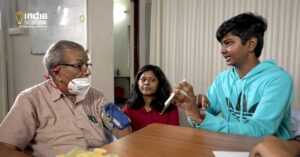Don’t Let Dengue and Chikungunya Scare You. Be Prepared with This Comprehensive Guide
Taking a few important steps to keep yourself, your family and your friends safe can make a huge difference in the battle against dengue and chikungunya. Here is all you need to know about the symptoms, key differences, treatment, natural repellents, immunity boosters, and preventive measures for these diseases.

It has been a wet August for the country with heavy downpours and rain-like conditions persisting for days on end. Puddles of stagnant rainwater, left in the wake, have turned several cities in India into breeding grounds for mosquitoes. As a result, mosquito-borne diseases like chikungunya and dengue are taking their toll on the National Capital Region and a few other cities across the country, with hospitals overwhelmed by affected patients.
Both chikungunya and dengue are viral diseases that are transmitted by the Aedes mosquito. The symptoms for both diseases are similar but there are some key differences that set them apart, which, if not detected and treated on time, may prove fatal.

Photo Source
There are no clear treatments for the diseases, nor is there a vaccine against them, so the best way to remain safe is to prevent them from occurring at all.
Taking a few important steps to keep yourself, your family and your friends safe can make a huge difference in the battle against dengue and chikungunya. Here is all you need to know about the symptoms, key differences, treatment, natural repellents, immunity boosters, and preventive measures for these diseases.
1. Causes
Dengue: This viral disease is transmitted to human bodies through the bite of female Aedes mosquitoes. It can also be transmitted from one infected human to another through blood transfusion and mosquito bites. However, it is not contagious, that is, it cannot be transferred directly between humans. The Aedes mosquito typically attacks during the day time and its favourite spots are below the elbows and below the knees.
Chikungunya: Chikungunya is caused by the same female Aedes mosquitoes that cause dengue. This ailment mostly affects the muscle cells of the body.
2. Symptoms
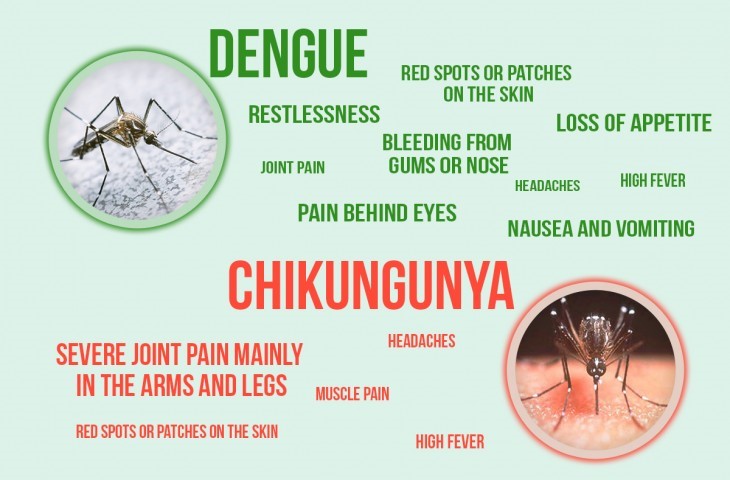
Photo Source
Dengue: The symptoms of dengue only appear 3 to 14 days after the mosquito bite and not immediately. A flu-like illness that affects infants, young children and adults alike, dengue patient suffer from fever for the initial three-four days, followed by body pain. Retro-orbital pain, that is, pain behind the eyes, is also common. In acute cases, decreased urine output, respiratory difficulties and increased bleeding tendencies also accompany the usual symptoms.
A more severe manifestation of this illness, dengue hemorrhagic fever, tends to affect children under 10 years of age. It can cause abdominal pain, bleeding, and also affect the circulatory system. People with weakened immune systems are also believed to be at greater risk for developing dengue hemorrhagic fever.
Chikungunya: The prominent symptoms of Chikungunya include excessive body pain or myalgia, swelling in the joints and rashes across the body. The body pain, in this case, is more severe than in dengue cases. Other than this, the symptoms for both mosquito bite-borne diseases are the same.
Note: Not all fevers lead to these diseases, with 90% non-specific virus illnesses settling down in 2-3 days. However, a consultation and blood test are advised if the fever continues after three days.
3. Treatment
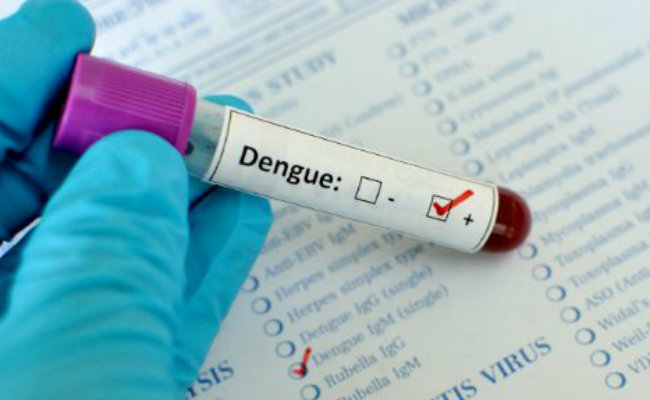
Photo Source
While for malaria, anti-malarial drugs like chloroquine and artemisinin are available, dengue and chikungunya are viral diseases and do not have treatment drugs as such. The treatment for dengue and chikungunya is symptomatic and, therefore, doctors wait for the symptoms to become evident in the body.
Chikungunya and dengue patients are given paracetamol for the fever to subside, but not in the first three days. This is because the body’s platelet count becomes lower than normal when affected by these diseases. So taking tablets like Non Steroidal Anti-Inflammatory Drugs (NSAID) or painkillers in the first two-three days can lead to bleeding in some cases.
Also, it is important to monitor the platelet count of the patient. Usually, the count goes down on or after the seventh day of the fever. However, the diseases can take a different route with children and the elderly.
At home, patients can rest, drink lots of water and maintain a high nutrition diet. It’s very important to increase the patient’s intake of fluids (water, fruit juices and electrolyte solutions) as dengue and chikungunya patients are prone to dehydration.
In case of very high fever, the patient should be covered with a wet sheet to bring down the temperature rapidly. This is because high fever (105-106 degrees) for a considerable time can lead to organ damage.
Also Read: 7 Ways This New Website Can Help Dengue Patients in Gurugram
4. Prevention

Photo Source
- Turn over empty pails and buckets, so that they do not collect excess water. If the container that contains water cannot be emptied, remember to cover it well when not in use.
- Remember to clean out empty flower pots and not to over water potted plants. It is advisable not to have any stagnant water around as it acts as a breeding ground for the mosquitoes.
- Ensure that no rain water is collected in discarded objects (broken containers, tanks, old tyres, bird baths, coconut shells) in your premises.
- Report locations of stagnant water to the local health officer or disease control room immediately.
- Apply mosquito repellents on all exposed areas, during the day as well as at night on a regular basis during disease outbreaks.
- If you are going out during the day, ensure that you wear light coloured clothes that cover the extremities of your bodies well. This is especially important for the elderly, who tend to take a stroll in the park, and for children, who play outdoors.
- Mosquitoes tend to stay indoors, so install a mesh or any other sort of barrier on your windows to keep them out.
- If you use a cooler, remember to empty out and clean the water tray regularly, even when not in use.
- Always cover your trash can or dustbin when not in use.
- Use natural repellents to keep mosquitoes at bay.
5. Natural Ways to Keep Your Home Mosquito-Free
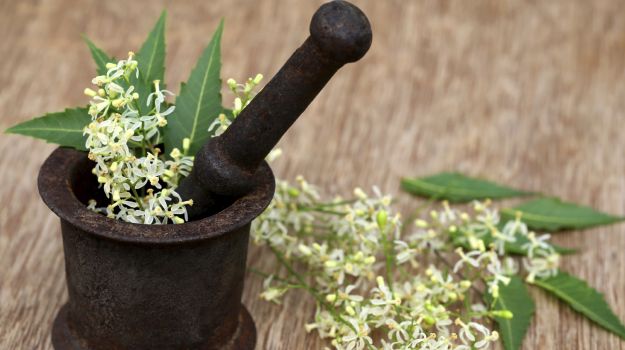
Photo Source
Neem oil: If you have been wondering how to kill mosquitoes, neem oil mixed with coconut oil in a 1:1 ratio acts is a great indoor mosquito-repellent. Other than being a potent antibacterial, anti-fungal, antiviral, and anti-protozoal agent, neem oil lends your skin a particular smell that wards off mosquitoes.
Eucalyptus and lemongrass oil: Recommended by the CDC (Center for Disease Control) as an effective indoor insect-repellent, the mixture of lemongrass oil and eucalyptus oil is extremely effective in repelling mosquitoes naturally. Lemongrass oil and eucalyptus oil work well due to their active component cineole, which has both antiseptic and insect-repellent properties when applied to the skin.
Camphor: Made from the extract of a tree, camphor has been found to have the longest mosquito repellent activity when compared to other natural products. Burn camphor (or camphor oil in a diffuser) in a room and close all the doors and windows. Leave it this way for about fifteen to twenty minutes for a mosquito free environment.
Tulsi: According to several studies, tulsi is extremely effective in keeping mosquitoes away. Simply planting a tulsi shrub near your window can prevent mosquitoes from entering your house.
Garlic: Garlic may have a strong and pungent odour but that is exactly why mosquitoes stay away. Crush a few pods of garlic, boil them in water and sprinkle the water in the room you want to keep mosquito free.
Citronella Oil: Citronella oil is one of the essential oils obtained from the leaves and stems of different species of Cymbopogon (the lemongrass family). A natural insect repellent, citronella can be used in the form of a diffuser oil or as a balm that can be directly applied on skin.
Tea tree oil: A very powerful antibacterial and antifungal agent, tea tree oil is also perfect to drive mosquitoes away. Mix it with coconut oil to rub it on your skin or add a few drops of it to a vaporizer to let its smell permeate the house.
Mint: Mint oil and mint extract are effective indoor mosquito repellents. You can use the oil in a vaporizer to help fill the room with its invigorating scent, apply the oil on your body or plant the shrub outside your room’s window.
Lavender: Not only does it smell divine but it is also a great way to keep those pesky mosquitoes at bay. To use this as a natural repellent, use a mix of lavender oil and water as a natural room freshener or apply it on your skin (you can mix it with your cream).
Plant mosquito-repellent vegetation: Planting the right kind of shrubs and trees can go a long way in keeping your home mosquito free. Shrubs of tulsi, mint, marigold, trees of lemon and neem, and citronella grass are all extremely effective in preventing the breeding of mosquitoes in your surroundings.
You May Like: 4 School Girls from Nagpur Develop an Eco-Friendly Mosquito Repellent System
6. Immunity Boosters
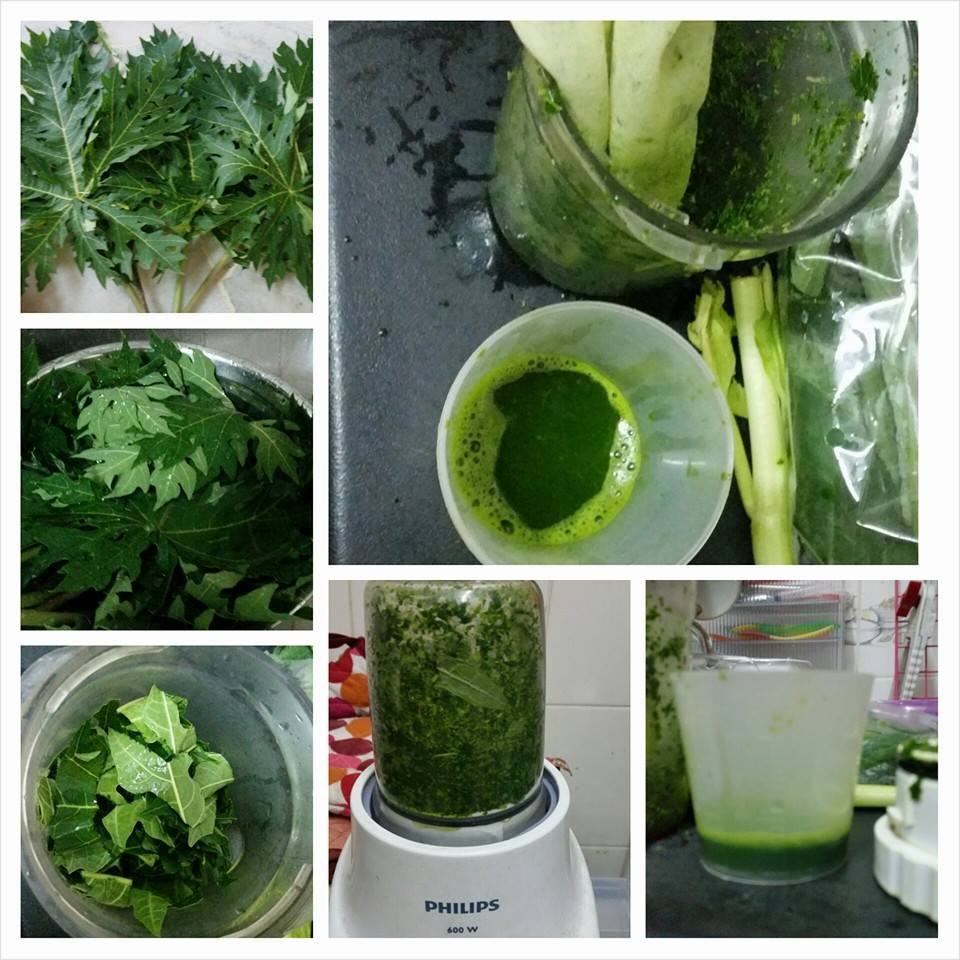
Photo Source
Papaya Leaves: Papaya leaves are believed to help increase platelet counts. Papaya leaves also contain important nutrients that support the immune system, including vitamins A, C, and E. Simply crush and squeeze a handful of papaya leaves to extract the juice. Consume 1-2 tbsp of the juice every day in the morning and night.
Giloy (Guduchi): Giloy or Tinospora cordifoila is an important anti-inflammatory and antipyretic herb in Ayurveda. Take branches of this climbing herb, cut them into small pieces and boil them in water. When the mixture reduces to half, let it cool down to room temperature. Mix it with orange juice before giving it to the patient twice a day.
Fenugreek Leaves (Methi): These leaves are known to reduce fever, ease pain and promote more restful sleep for patients. Soak the leaves or mix powdered fenugreek in water and then drink it.
Tulsi Ginger Tea: While tulsi enhances endurance, increases oxygen utilization, boosts the immune system, fights infection and provides a rich supply of anti-oxidants and other nutrients, ginger is very effective in combating fever induced nausea and weakness.
7. Diet Tips for Dengue and Chikungunya

Photo Source
More Fluid Intake: Maximum intake of fluid is the first thing to include in the diet for dengue patients. It’s advisable to include nutrient rich fluids apart from liquids such as ORS, sugar cane juice, tender coconut water, lime juice, fresh orange juice, and various fruit juices. Drinking plenty of fluids helps in removing toxins from the body.
Increase Vitamin C Intake: Vitamin C can aid in improving cellular immunity and preventing dengue hemorrhagic fever. Fruits like orange, pineapple, strawberry, guava, and kiwi boost the production of lymphocytes, which fight the viral infection.
No Spicy and Oily Food: Spicy, oily and processed foods are a big no for patients recovering from dengue fever. Not only are they difficult to digest, they also aggravate the symptoms of fever. Instead, snack on dry fruits like raisins and dates. Caffeine and alcohol, known for their diuretic properties, are also best avoided to prevent dehydration.
Diet Rich in Protein: Low fat curd, egg whites, cottage cheese, chicken, and fish are highly recommended foods for patients recovering from dengue and chikungunya. A protein rich diet helps the body regain essential nutrients, aiding quick recovery.
There is a need for a multi-pronged campaign to rid the country of dengue or at least to reduce the deadly impact of these diseases that spike every year during and after monsoon.
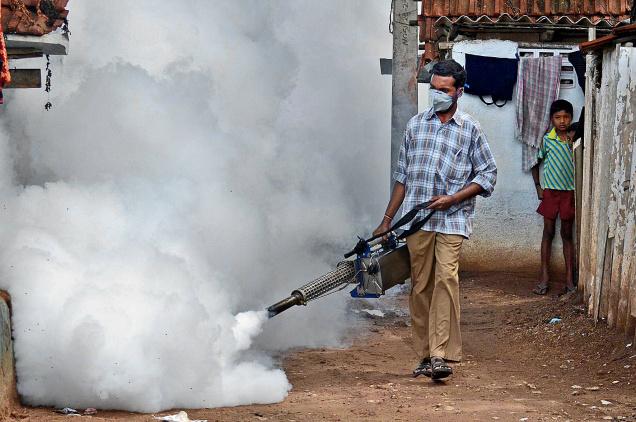
Photo Source
Also, it is important that their prevention and control happens throughout the year and not just when figures rise to epidemic proportions.
Here are a few steps that can make a difference:
- A proactive surveillance system: There is a need to keep looking as to where the first cases emerge from and report them immediately. All clinics and hospitals, both government and private, should be able to inform the authorities immediately, when there are suspected cases of dengue or chikungunya.
- Rapid response emergency vector control: With a focus on eradicating breeding places, prompt action should be taken to spray and fog suspected breeding grounds.
- An awareness campaign to ensure that patients seek early hospitalization during an epidemic: When dengue and chikungunya cases start appearing, people need to be aware of what they should do at the first signs, such as seeking treatment from proper hospitals with facilities for blood tests.
- Health personnel training: Health personnel should be given continuous training in the management and monitoring of dengue patients.
- Involve communities in long-term control of mosquito-borne diseases in their areas: This bottom-up approach that should be in place throughout the year can help stop the spread of dengue. It would involve keeping homes and neigbourhoods free of garbage, stagnant water, and containers such as foam boxes, broken pots, disposable containers, coconut shells, old tyres, etc.
The contact details for Government Control Rooms for dengue and chikungunya in major cities are given below:
Delhi Control Room Number: 011-22307145
Bengaluru Control Room Number: 080-22660000
Kolkata Control Room Number: 033-22861212
Thiruvananthapuram Control Room Number: 0471-2552056
Also See: VIDEO: ‘Dengue-Free’ Coolers Introduced in Delhi to Check Spread of the Disease
Like this story? Have something to share? Email: [email protected], or join us on Facebook and Twitter (@thebetterindia). To get positive news on WhatsApp, just send ‘Start’ to 090 2900 3600 via WhatsApp.
This story made me
- 97
- 121
- 89
- 167
Tell Us More
We bring stories straight from the heart of India, to inspire millions and create a wave of impact. Our positive movement is growing bigger everyday, and we would love for you to join it.
Please contribute whatever you can, every little penny helps our team in bringing you more stories that support dreams and spread hope.








